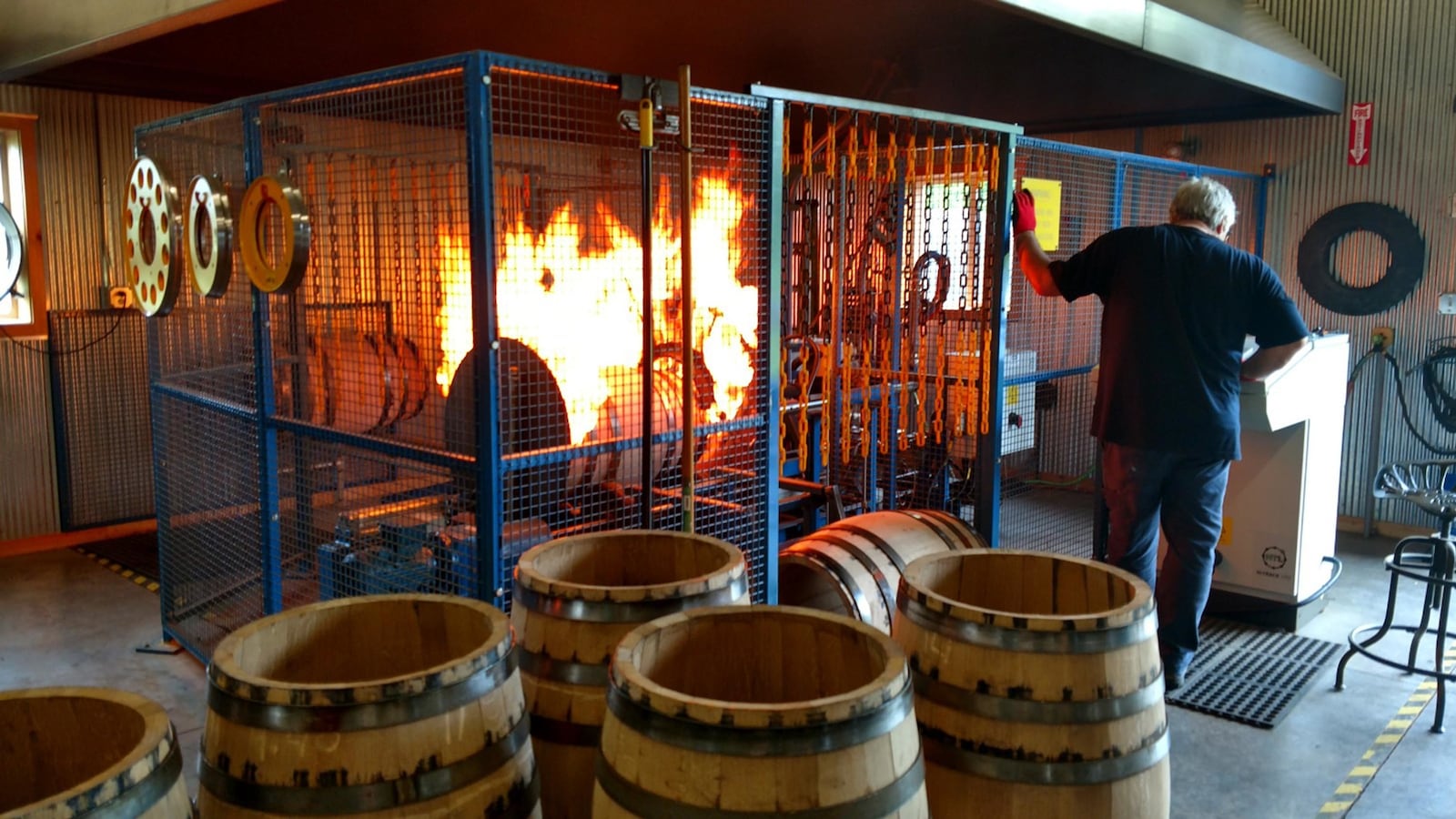It was a classic January day in upstate New York: gray overcast skies, six inches of snow cover and more lightly drifting down. I was on my way to the Adirondack Barrel Cooperage (ABC) in Remsen about half an hour north of Utica. It’s one of the new, small cooperages that have popped up in America in response to the surge of small-scale spirits and beer makers.
In a recent story, I wrote about how craft brewing and distilling are putting up some impressive employment numbers, especially when you include what economists call the multiplier effect, the jobs in affiliated industries. Cooperages, a truly old-timey business that had shrunk right along with the bourbon industry, have hugely benefited from this craft liquor boom.
Now the Associated Cooperage Industries of America has about 20 new cooperage members, plus there are others that have opened that are unaffiliated with the trade organization. Like the small distillers they supply, these new cooperages are trying new things: Some are highly automated, some are using fiercely traditional methods, some are experimenting with new woods. In response, like the big distillers, the established cooperages are rising to the challenge with their own innovations.
One of the most fiercely debated new developments is the question of how the wood is “seasoned” before being made into barrels. Seasoning takes into account the time between when the tree is cut down, inspected, rough-milled into staves and then made into barrels. While it sounds straightforward, the wood needs to be dried between milling and becoming a barrel—anywhere from four to about 48 months of air drying, and/or kiln drying.

For air drying, the wood has to be stacked just right in order to let air and moisture circulate without creating pockets where the wood stays wet. But you also want some moisture on the wood to promote the growth of beneficial fungus that begins the breakdown of structure and compounds that make oak more than just a container. It’s best to dry it on stone or gravel to cut down on bug infestation.
With proper seasoning, along with the toasting and charring that creates sweeter flavors, oak becomes a major partner in the creation of whiskey flavor. That’s why seasoning has become a selling point for the higher end of the barrel and bourbon market.
I went to the Adirondacks on a tip that ABC was using extra-seasoned wood. The company is run by Kelly and Joe Blazosky. Joe was a master carpenter and had a construction firm. He sold the business in 2009 and was looking for a new one.
“It was the barrel shortage in 2013 that got me thinking,” he told me, referring to the weather-related problems that stymied cooperages. “The smaller distillers had a harder time getting barrels. We talked to New York State producers, and it looked like there was a market.” After writing a business plan, learning coopering at Oregon Barrel Works, and designing some new machinery to make barrels, Joe started production in March of 2016.
ABC is much more high-tech in how they make barrels than any traditional operation I’ve seen. Each stave is cut and shaped to size by an automated machine that then smooths each side. As each stave is selected, a worker checks it, weighs it in his or her hand, and decides if it’s good enough to go into a barrel. The barrel heads (the ends) are made from pieces that are grooved and joined without glue or dowels.
Once the staves are cut, and the barrel is “raised,” or assembled, it’s ready for the heat. Toasting and charring are done with the assistance of temperature probes to make sure the individual barrel gets exactly the heat it needs. “There is a lot of technology,” Joe said, “but it’s all in the service of the craft.”

ABC barrels do look like the product of a master carpenter: smooth, uniform and every custom-forged hoop is in exactly the same place. They aren’t just pretty, they’re sound. “In all the time we’ve been open, all the barrels we’ve made,” Joe said, “we’ve had one leaky barrel. One. I don’t even have any rushes in the building.” Dried rushes are used to plug tiny cracks in new barrels, and you’ll see them used at large cooperages where they literally make as many barrels in a day as ABC makes in a year.
But it all starts with the wood, and Blazosky goes a long way with that as well. He doesn’t use local oak, which I guess I had expected with the craft ethos and the popularity of hyper-local ingredients. “It’s just not the right wood,” he said. He instead sources white oak from Missouri and every piece of it is air dried for three to four years.
What exactly does longer seasoning do? I talked to Matt Hofmann, the co-founder and master distiller at Westland Distillery in Seattle about that. Hofmann has a program of aging malt whiskey in Garryana oak, a species native to the West Coast, which is also known as Oregon white oak. He told me about work the late Dr. Jim Swan, a pioneering wood expert in the industry, had done on Garryana oak chemistry.
“One of the things he identified in Garryana was a high tannin level,” Hofmann told me, “and that’s one of the things that benefits more from air drying. It breaks down tannin. [All the wood] we use in the Garryana barrels has been air dried three years or longer because of that tannin level. We have some stuff that’s been sitting out for 20 years, and we’re trying some two-year stuff just to see the difference.”
This is a topic of interest for the big cooperages as well. Brown-Forman recently flew me out to their cooperage in Louisville, Kentucky, to see how barrel differences change the character of their new Coopers’ Craft Barrel Reserve Bourbon. Their innovative “chiseled” technique cuts grooves in the charred barrel, parallel to the head, with the shavings staying in the barrel for extra surface area exposure. The technique gives the spirit a rich character without going heavy and chewy on the wood.
I sat down with Greg Roshkowski, the vice president and general manager of the Brown-Forman cooperage. We talked about air drying, and that’s when the details on tannins came out. “You’re going from about 50-percent moisture in the wood to about 22-percent in four to six months of air-drying,” he explained. I asked how that works when the wood is sitting out literally in the rain.
“That’s the difference between surface water and ‘bound’ water in the cells,” Roshkowski said. “As the bound water comes out, it brings the tannins with it. If you dry it too quickly, there’s no leaching, and it’s less pliable.” That also causes problems when it’s time to bend the wood into a barrel shape.
Kiln drying is still used, but it’s used to get all the wood to the same moisture level once the tannins have had a chance to leach out. It takes a while. “A four-year-old whiskey has another year in the yard,” Roshkowski said, meaning the time the wood spent air drying.
Seasoning is part of the process that breaks down lignin, the woody structure in oak, into 23 different sugars. “As the lignin breaks down,” he said, “it releases those sugars. It breaks down through heat from the toasting and charring, from age in the drying process, and partly through the bending when the staves are formed.”
Air drying is also key for making white oak the best wood for holding liquids. Trees have tiny pores in order to transfer liquids up and down the trunk. But white oak plugs those pores as the wood dries and seasons with a natural compound called tyloses, making it uniquely qualified for holding whiskey and other liquids.
But overall how much benefit do you get from exceptionally long air-drying? Luckily, Buffalo Trace does such experimentation regularly, and they just happened to conclude one on this topic. Experimental Collection #22 compared whiskey aged in barrels made of wood air dried for 36 and 48 months. The 48-month whiskey was more mellow, less biting, but the younger wood had given its whiskey a more interesting set of flavors.
Buffalo Trace master distiller Harlen Wheatley wasn’t just looking for differences between 36- and 48-month-old wood. “We were trying to determine the differences in 12, 24, 36, and 48 months overall against our standard six-month seasoned wood,” he told me.
Isn’t that a short aging time? “That is not typical for the industry,” Wheatley agreed, but not for the reason I thought. “Typically, a barrel might only be two to three months with kiln dried wood. As the wood ages, the tannins are broken down and creates a softer finish. It does seem to change as you move out and new flavors are created based on the wood. We are very happy with six to 12 months.”
If that’s the young end, what’s the far end, the longest you can go? I was told one distiller was experimenting with eight years of air-drying. Roshkowski was skeptical. “Past four years, you’re going to start losing wood. If you’re losing that much, it’s not making economic sense.”
I think that’s where this comes together, because “economic sense” for Roshkowski and Brown-Forman making 2,500 barrels a day (at just one of their two cooperages) isn’t necessarily “economic sense” for the Blazoskys, making 2,500 barrels a year. ABC uses longer-seasoned wood, and the barrels are shaped to much higher tolerances than Roshkowski requires. But on the other hand, the whiskey I’ve had coming out of the Brown-Forman barrels tastes pretty damn good.
Big cooperages making barrels for big producers have pretty much settled on between 6 and 24 months of air drying, and may go longer for special projects. Going longer than 24 months, though, has higher costs, but it may have benefits, or at least, differences. Those differences may not be to everyone’s palate, or pocketbook.
But the whiskey aficionado is looking for difference. Longer air drying with precision toasting and charring, much like using heirloom grains or pot stills, gives smaller distillers valuable points of differentiation. That’s why places like Adirondack Barrel Cooperage probably have a solid future.






